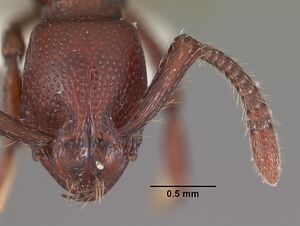Loboponera obeliscata
| Loboponera obeliscata | |
|---|---|

| |
| Scientific classification | |
| Kingdom: | Animalia |
| Phylum: | Arthropoda |
| Class: | Insecta |
| Order: | Hymenoptera |
| Family: | Formicidae |
| Subfamily: | Ponerinae |
| Tribe: | Ponerini |
| Genus: | Loboponera |
| Species: | L. obeliscata |
| Binomial name | |
| Loboponera obeliscata Bolton & Brown, 2002 | |
Nothing is known about the biology of Loboponera obeliscata.
Identification
Bolton & Brown (2002) - A member of the obeliscata species group. Closest related to Loboponera politula but easily distinguished by the unique shape of the petiole node.
Keys including this Species
Distribution
Latitudinal Distribution Pattern
Latitudinal Range: 6.5° to 6.5°.
| North Temperate |
North Subtropical |
Tropical | South Subtropical |
South Temperate |
- Source: AntMaps
Distribution based on Regional Taxon Lists
Afrotropical Region: Gabon, Ghana (type locality), Ivory Coast.
Distribution based on AntMaps
Distribution based on AntWeb specimens
Check data from AntWeb
Countries Occupied
| Number of countries occupied by this species based on AntWiki Regional Taxon Lists. In general, fewer countries occupied indicates a narrower range, while more countries indicates a more widespread species. |

|
Estimated Abundance
| Relative abundance based on number of AntMaps records per species (this species within the purple bar). Fewer records (to the left) indicates a less abundant/encountered species while more records (to the right) indicates more abundant/encountered species. |

|
Biology
Castes
Worker
Images from AntWeb
  
| |
| Holotype of Loboponera obeliscata. Worker. Specimen code casent0102324. Photographer April Nobile, uploaded by California Academy of Sciences. | Owned by NHMUK, London, UK. |
Nomenclature
The following information is derived from Barry Bolton's Online Catalogue of the Ants of the World.
- obeliscata. Loboponera obeliscata Bolton & Brown, 2002: 5, figs. 3, 4 (w.) GHANA.
Unless otherwise noted the text for the remainder of this section is reported from the publication that includes the original description.
Description
Worker
Holotype. TL 5.6, HL 1.13, HW 1.00, CI 88, SL 0.97, SI 97, AL 1.64. Paratype. TL 5.7, HL 1.14, HW 1.00, CI 88, SL 1.00, SI 100, AL 1.72. Characters of obeliscata group and the following. Eye minute and difficult to see, scarcely larger than one of the adjacent foveolate punctures; maximum diameter 0.04. Scape when laid back in full-face view reaches occipital margin. Small lobe at anterolateral angle of clypeus distinctly prominent. Propodeal lamella broad at sides, narrowing near dorsal angle and thinly continued onto dorsum but narrowed medially or with a mid-dorsal gap. Propodeal declivity finely transversely striate. Petiole in profile with anterior and posterior margins more or less parallel and with the dorsal surface extended medially into a high subpyramidal blunt point; in posterior view the sides slope steeply upward to a pointed apex. First gastral tergite in profile with its anterior face distinctly inclined posteriorly from top to bottom, in dorsal view overhanging the helcium.
Type Material
Holotype worker, Ghana: Tafo, 9.ix.1966, ant ecology sample 251 (D. Leston) (The Natural History Museum). Paratype. 1 worker with same data as holotype (Museum of Comparative Zoology).
References
- Bolton, B. and Brown, W. L., Jr.. 2002. Loboponera gen. n. and a review of the Afrotropical Plectroctena genus group (Hymenoptera: Formicidae). Bulletin of the Natural History Museum London (Entomology). 71:1-18. (page 5, figs. 3, 4 worker described)
- Esteves, F.A., Fisher, B.L. 2021. Corrieopone nouragues gen. nov., sp. nov., a new Ponerinae from French Guiana (Hymenoptera, Formicidae). ZooKeys 1074, 83–173 (doi:10.3897/zookeys.1074.75551).
References based on Global Ant Biodiversity Informatics
- Bolton B., and W. L. Brown Jr. 2002. Loboponera gen. n. and a review of the Afrotropical Plectroctena genus group (Hymenoptera: Formicidae). Bulletin of the Natural History Museum. Entomology Series 71: 1-18.
- Yeo K., S. Konate, S. Tiho, and S. K. Camara. 2011. Impacts of land use types on ant communities in a tropical forest margin (Oumé - Cote d'Ivoire). African Journal of Agricultural Research 6(2): 260-274.

